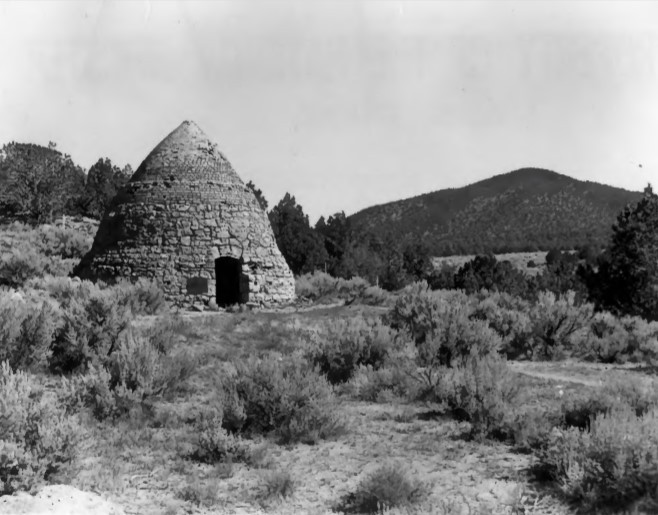Pioneer Iron Works Blast Furnace
Introduction
Text-to-speech Audio
Images
Ruins of foundry at Iron Town, similar to what stood at Cedar City in 1850s (Smith 1971)

Former coke oven at Old Iron Town, made of brick (Smith 1971)

Backstory and Context
Text-to-speech Audio
Colonel A.W. Hamilton, a mining expert, remarked that the "iron deposits of Utah are measured in mountains and the coal measured by counties." John S. Newberry of the New York School of Mines described the southern Utah area as having the "most remarkable deposit of iron yet found" on the continent. The region had plentiful juniper trees (no, not cedar - the town name is a misnomer) for making charcoal to fuel the iron furnace.
Brigham Young disapproved of Mormons mining for precious metals like silver and gold but he recognized that ironworking was a different matter and necessary for pioneer settlers in remote Utah to obtain and replace tools. The location for the iron works along Coal Creek was settled in November 1851 by a group of Mormons called "iron missionaries," sent from the base camp of nearby Parawan. The iron works in what became Cedar City were initially successful, and the operations were renamed the Deseret Iron Company in 1852. The furnace keeper was named David Barklay Adams. The first coke oven and blast furnace were finished in 1852 and some of the first iron items created that September from several hundred pounds of iron were a cast bell, nails, hooks, and rods. The settlers ran up against many obstacles. Floods, freezes, and crop shortages tested the pioneers. Financial difficulties and unrest with the Native American population added to the misery. The iron works was closed in 1858 and many residents moved elsewhere. The settlement became an agrarian town. Decades later, a son of David B. Adams described the layout of the iron works to his own son, R.D. Adams, who painted a bustling scene based on his father's recollections. The image pictures a wood frame office, a pattern makers shop, a test furnace and the larger blast furnace, a line of coke ovens, and a holding shop.
Another iron foundry was founded in 1868 twenty miles southwest of Cedar City and christened Iron City by the Mormon settlers. The Union Iron Company was organized, headed by Ebenezer Banks, a successful merchant. A town was laid out in the typical Mormon way, similar to Cedar City, with blocks 240 rods square, lots 12 by 6 rods, and streets 4 rods in width. The heat-resistant fire brick needed to line the interior of the blast furnace was hard to come by, and the operations didn't begin until 1871. Transportation problems from the remote new town to Salt Lake City and the proliferation of railroad lines across the nation resulted in competition and decreased freight rates. Iron became cheaper to buy from the Eastern U.S. than from Iron Town. To solve this disadvantage, a railroad spur was proposed to connect Iron City with Salt Lake City in the mid-1870s, but it did not happen.
Another issue was a lack of skilled workers of the Mormon faith; non-Mormons were brought to town as iron workers and consultants. Some of the iron workers who moved to Iron Town had been the Cedar City iron workers, including the furnace keeper, David B. Adams. Adams had been a Mormon bishop in Beaver and served as the head of the LDS Church in Iron City. Other locals who worked at the new iron works included Ebenezer Hanks and brothers Chapman and Homer Duncan. Iron production ceased around 1876 and Iron City has become a ghost town. The Old Iron Town ruins are listed in the National Register and include a beehive-shaped kiln of brick, the stone foundations of the foundry, and a circular feature called an "arastra" where sand was ground into fine particles to use in the furnace molds. The ruins were fenced off by the Sons of Utah Pioneers and are now open to tourists under the management of Iron Mission State Park.
Sources
Bate, Kerry William. Iron City, Mormon Mining Town. Utah Historical Quarterly, vol. 50, no. 1, Winter, 47 - 58. Published November 1st 1982.
Kirchner, Bill. Pioneer Iron Works Blast Furnace, Historical Markers Database. June 16th 2016. Accessed August 29th 2020. https://www.hmdb.org/m.asp?m=59545.
Shirts, Morris A. William T. Parry. The Demise of the Deseret Iron Company: Failure of the Brick Furnace Lining Technology. Utah Historical Quarterly, Winter, vol. 56, no. 1, 23 - 35. Published November 1st 1988.
Smith, Melvin T.. NRHP Nomination of Old Iron Town. National Register. Washington, DC. National Park Service, 1971.
Utah State Parks. Iron Mission State Park, State Parks. Accessed August 25th 2020. https://www.stateparks.com/iron_mission_state_park_in_utah.html.
https://npgallery.nps.gov/NRHP/AssetDetail?assetID=3751f2c7-2faa-484d-b236-47fde5bc5b65
https://npgallery.nps.gov/NRHP/AssetDetail?assetID=3751f2c7-2faa-484d-b236-47fde5bc5b65
